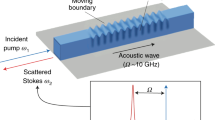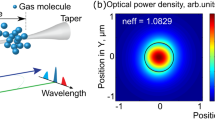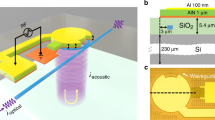Abstract
Both Kerr and Raman nonlinearities are radically enhanced by tight optical-mode confinement in nanoscale silicon waveguides1,2,3,4. Counterintuitively, Brillouin nonlinearities—originating from coupling between photons and acoustic phonons—are exceedingly weak in these same nonlinear waveguides5. Strong Brillouin interactions have only recently been realized in a new class of optomechanical structures that control the interaction between guided photons and phonons5,6,7. Despite these major advances, appreciable Brillouin-based optical amplification has yet to be observed in silicon. Using a membrane-suspended waveguide, we report large Brillouin amplification in silicon for the first time, reaching levels greater than 5 dB for modest pump powers, and demonstrate a record low (5 mW) threshold for net amplification. This work represents an important step towards the realization of high-performance Brillouin lasers and amplifiers in silicon.
This is a preview of subscription content, access via your institution
Access options
Subscribe to this journal
Receive 12 print issues and online access
$209.00 per year
only $17.42 per issue
Buy this article
- Purchase on Springer Link
- Instant access to full article PDF
Prices may be subject to local taxes which are calculated during checkout



Similar content being viewed by others
References
Rong, H. et al. Raman gain and nonlinear optical absorption measurements in a low-loss silicon waveguide. Appl. Phys. Lett. 85, 2196–2198 (2004).
Rong, H. et al. A continuous-wave Raman silicon laser. Nature 433, 725–728 (2005).
Jalali, B. et al. Prospects for silicon mid-IR Raman lasers. IEEE J. Sel. Top. Quantum Electron. 12, 1618–1627 (2006).
Foster, M. A. et al. Broad-band optical parametric gain on a silicon photonic chip. Nature 441, 960–963 (2006).
Rakich, P. T., Reinke, C., Camacho, R., Davids, P. & Wang, Z. Giant enhancement of stimulated Brillouin scattering in the subwavelength limit. Phys. Rev. X 2, 011008 (2012).
Shin, H. et al. Tailorable stimulated Brillouin scattering in nanoscale silicon waveguides. Nature Commun. 4, 1944 (2013).
Van Laer, R., Kuyken, B., Van Thourhout, D. & Baets, R. Interaction between light and highly confined hypersound in a silicon photonic nanowire. Nature Photon. 9, 199–203 (2015).
Vidal, B., Piqueras, M. A. & Martí, J. Tunable and reconfigurable photonic microwave filter based on stimulated Brillouin scattering. Opt. Lett. 32, 23–25 (2007).
Li, M. et al. Harnessing optical forces in integrated photonic circuits. Nature 456, 480–484 (2008).
Zhang, W. & Minasian, R. Ultrawide tunable microwave photonic notch filter based on stimulated Brillouin scattering. IEEE Photon. Technol. Lett. 24, 1182–1184 (2012).
Pant, R. et al. On-chip stimulated Brillouin scattering for microwave signal processing and generation. Laser Photon. Rev. 8, 653–666 (2014).
Shin, H. et al. Control of coherent information via on-chip photonic–phononic emitter–receivers. Nature Commun. 6, 6427 (2015).
Li, J., Lee, H. & Vahala, K. J. Microwave synthesizer using an on-chip Brillouin oscillator. Nature Commun. 4, 2097 (2013).
Marpaung, D. et al. Low-power, chip-based stimulated Brillouin scattering microwave photonic filter with ultrahigh selectivity. Optica 2, 76–83 (2015).
Kang, M. S., Nazarkin, A., Brenn, A. & Russell, P. St. J. Tightly trapped acoustic phonons in photonic crystal fibres as highly nonlinear artificial Raman oscillators. Nature Phys. 5, 276–280 (2009).
Braje, D., Hollberg, L. & Diddams, S. Brillouin-enhanced hyperparametric generation of an optical frequency comb in a monolithic highly nonlinear fiber cavity pumped by a cw laser. Phys. Rev. Lett. 102, 193902 (2009).
Olsson, N. & van der Ziel, J. Fibre Brillouin amplifier with electronically controlled bandwidth. Electron. Lett. 22, 488–490 (1986).
Abedin, K. S. et al. Single-frequency Brillouin distributed feedback fiber laser. Opt. Lett. 37, 605–607 (2012).
Li, J., Lee, H. & Vahala, K. J. Low-noise Brillouin laser on a chip at 1064 nm. Opt. Lett. 39, 287–290 (2014).
Gao, F. et al. On-chip high sensitivity laser frequency sensing with Brillouin mutually-modulated cross-gain modulation. Opt. Express 21, 8605–8613 (2013).
Yu, Z. & Fan, S. Complete optical isolation created by indirect interband photonic transitions. Nature Photon. 3, 91–94 (2009).
Kang, M. S., Butsch, A. & Russell, P. St. J. Reconfigurable light-driven opto-acoustic isolators in photonic crystal fibre. Nature Photon. 5, 549–553 (2011).
Huang, X. & Fan, S. Complete all-optical silica fiber isolator via stimulated Brillouin scattering. J. Lightwave Technol. 29, 2267–2275 (2011).
Kim, J., Kuzyk, M. C., Han, K., Wang, H. & Bahl, G. Non-reciprocal Brillouin scattering induced transparency. Nature Phys. 11, 275–280 (2015).
Yao, X. Brillouin selective sideband amplification of microwave photonic signals. IEEE Photon. Technol. Lett. 10, 138–140 (1998).
Okawachi, Y. et al. Tunable all-optical delays via Brillouin slow light in an optical fiber. Phys. Rev. Lett. 94, 153902 (2005).
Loayssa, A., Benito, D. & Garde, M. J. Optical carrier Brillouin processing of microwave photonic signals. Opt. Lett. 25, 1234–1236 (2000).
Laer, R. V., Bazin, A., Kuyken, B., Baets, R. & Thourhout, D. V. Net on-chip Brillouin gain based on suspended silicon nanowires. New J. Phys. 17, 115005 (2015).
Wolff, C., Laer, R. V., Steel, M. J., Eggleton, B. J. & Poulton, C. G. Brillouin resonance broadening due to structural variations in nanoscale waveguides. New J. Phys. 18, 025006 (2016).
Wolff, C., Gutsche, P., Steel, M. J., Eggleton, B. J. & Poulton, C. G. Power limits and a figure of merit for stimulated Brillouin scattering in the presence of third and fifth order loss. Opt. Express 23, 26628–26638 (2015).
Agrawal, G. P. Nonlinear Fiber Optics (Academic, 2007).
Barwicz, T. & Haus, H. A. Three-dimensional analysis of scattering losses due to sidewall roughness in microphotonic waveguides. J. Lightwave Technol. 23, 2719 (2005).
Dong, P. et al. Low loss shallow-ridge silicon waveguides. Opt. Express 18, 14474–14479 (2010).
Claps, R., Raghunathan, V., Dimitropoulos, D. & Jalali, B. Influence of nonlinear absorption on Raman amplification in silicon waveguides. Opt. Express 12, 2774–2780 (2004).
Mathlouthi, W., Rong, H. & Paniccia, M. Characterization of efficient wavelength conversion by four-wave mixing in sub-micron silicon waveguides. Opt. Express 16, 16735–16745 (2008).
Gajda, A. et al. Highly efficient CW parametric conversion at 1550 nm in SOI waveguides by reverse biased p-i-n junction. Opt. Express 20, 13100–13107 (2012).
Acknowledgements
Primary support for this work was provided by the MesoDynamic Architectures programme at DARPA under the direction of D. Green. This work was supported in part by the Packard Fellowship for Science and Engineering. H.S. acknowledges support from new faculty startup funding at POSTECH. We thank P. Kharel for technical discussions involving phononic systems and nonlinear interactions, and M. Rooks and M. Power for assistance with process development. We are grateful to R. Behunin, W. Renninger and W.P. Rakich for careful reading and critique of this manuscript.
Author information
Authors and Affiliations
Contributions
E.A.K. and H.S. fabricated the waveguide devices. P.T.R., H.S. and E.A.K. developed multiphysics simulations for and designed the devices. E.A.K. and H.S. conducted experiments with the assistance of P.T.R. P.T.R., H.S. and E.A.K. developed analytical models to interpret measured data. All authors contributed to the writing of this paper.
Corresponding author
Ethics declarations
Competing interests
The authors declare no competing financial interests.
Supplementary information
Supplementary information
Supplementary information (PDF 6239 kb)
Rights and permissions
About this article
Cite this article
Kittlaus, E., Shin, H. & Rakich, P. Large Brillouin amplification in silicon. Nature Photon 10, 463–467 (2016). https://doi.org/10.1038/nphoton.2016.112
Received:
Accepted:
Published:
Issue Date:
DOI: https://doi.org/10.1038/nphoton.2016.112
This article is cited by
-
A narrow twist
Nature Photonics (2022)
-
Narrowband microwave-photonic notch filters using Brillouin-based signal transduction in silicon
Nature Communications (2022)
-
Hot carrier effects on Brillouin amplification in semiconductor magneto-plasmas
Indian Journal of Physics (2022)
-
Electrically driven acousto-optics and broadband non-reciprocity in silicon photonics
Nature Photonics (2021)
-
Stimulated plasmon polariton scattering
Nature Communications (2020)



